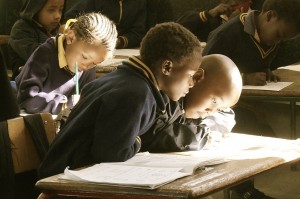
 In Part One, I wrote about the reasons why improvisation is a beneficial lesson supplement in the classroom as it helps students overcome barriers. For instance, a child who feels timid and typically does not volunteer to participate or speak during a regular question and answer session may eventually open up! Most importantly, if you use improvisation, it will get your class up and moving while having a fun time. This will stimulate thought, action, and discovery. Here are a few examples of activities that I have seen work amazingly in the classroom:
In Part One, I wrote about the reasons why improvisation is a beneficial lesson supplement in the classroom as it helps students overcome barriers. For instance, a child who feels timid and typically does not volunteer to participate or speak during a regular question and answer session may eventually open up! Most importantly, if you use improvisation, it will get your class up and moving while having a fun time. This will stimulate thought, action, and discovery. Here are a few examples of activities that I have seen work amazingly in the classroom:
The Tableau: Sequencing, Main Idea, and Teamwork
This activity is always a huge hit, and works wonderfully with elementary school age children, but any age can have fun with it. Tableaus are great for reading or literature classes when you want to get the kids out of their seats and on their feet.
Take the story you are reading in class and split it into sections. Divide the sections of the story among several groups in the class (be sure to have at least four people in a group, but more is better). Have the students identify what the main idea of their section is. Their task is to display the main idea of their section by making it a tableau, or, as I describe it to them, a “frozen picture.” They need to work as a team and try to USE LEVELS to keep the picture interesting. Encourage them to think outside the box (how can they use their bodies to form a waterfall, a windmill, or a bridge?) Not ALL involved have to portray characters; they can also be objects.
Give them time to rehearse (use your judgement) and when it is time to perform, have them display their tableaus one at a time, in the order that the story unfolds. The audience can try to guess who is who/what in the tableau, and what main idea they are trying to portray. This activity helps students exercise sequencing skills, reinforces the main idea, and encourages teamwork!
60-Second Fairytales: Key Details
In this activity, students have one minute to perform a well-known fairytale. This helps kids to not over think, use their instincts, and to experience some of the events in the fairytale. Plus, it’s fun and short! It also helps students identify and comprehend key details needed to tell a specific story.
Each group in the class should have at least three students, but four or five is better. One student is the Moderator, and it is their job to play the narrator and interact with the audience. The other students are the fairytale performers.
The audience will be asked to recommend different fairytale choices. For example, The Little Mermaid, Little Red Riding Hood, Hansel and Gretel, etc. The Moderator will choose a story that everyone in their group knows well. Once everyone agrees, the performance begins. The Moderator should give a brief summary of the fairy tale, being sure to talk about the key details of the story as a refresher (mainly for the actors). When the Moderator says, “Action!” the performers will begin to act out the story.
Remind students that their challenge is to keep their characters fun and interesting to watch despite the fact that they have a time limit. Also, remind them to establish a setting in the beginning and to create the conflict. The Moderator can jump in to assist if they become stumped by introducing a new event, and they can also monitor the time.
If you feel your class may not be able to handle one minute quite yet, you can play a four or five minute version.
Of course, this activity works for any stories and also for movies!
Living Wax Museum
In this improvisation activity, students pick or teachers can assign an historical figure to research, perhaps in a unit that your class is studying. After all the research is done, they will have the opportunity to “play” that person, improvising answers to questions from the class. It is fun to invite parents to watch these presentations, and set up the day as if it were a talk-show with a host!
Back to the “Yes, and…” Rule
As I mentioned in Part One, the number one rule of improvisation is “Yes, and….” In many classrooms, we hear the word “no” quite often (especially when it comes to classroom management). For example, “No running,” “No talking when the teacher or a friend is talking,” etc. By including improv in the classroom, the environment turns into a “Yes” environment. “Yes” is a positive word, and therefore, it typically yields positive behavior (“Yes, you may walk to the bathroom.” “Yes, you may have a turn to share your story after Bob.” “Yes, you may work with a partner if you are quiet.”) In improv, the kids are accepting their classmates’ ideas while contributing their own. Here is an example of the “Yes, and…” rule in improvised dialogue where “no” is not an option.
STUDENT #1: “I’m bored. Let’s go get ice cream!”
STUDENT #2: “That sounds great! I think I am going to order Dinosaur Crunch. What are you going to get?”
STUDENT #1: “Chocolate!”
STUDENT #2: “Then after that we can go surfing!!!
This example would be quite different if the word “no” was allowed. If that were the case, then Student #2 could simply shoot down all the ideas offered by the first student. They might decide to take complete control of the scene and shut down communication. In contrast, by saying “yes” all the time they are able to not only keep the dialogue moving, but they are also able to contribute their own ideas.
Teamwork Towards Learning
The last major reason I would like to share to inspire educators to incorporate improvisation activities in the classroom is the emphasis it puts on teamwork. A common rule in the classroom is that only one student talks at a time, and if someone else is talking, we need to give them 100% of our focus. It is difficult for kids to get into the habit of waiting their turn to speak because they become so excited. We want to embrace that excitement and not put out that spark. We want kids to feel confident in sharing their ideas and to feel inspired to share. They need to be reminded that everyone has great ideas worth sharing. In order for all ideas to be heard and understood, everyone needs to have a turn. With improvisation, the class becomes a team, or an ensemble. Ensembles contribute ideas and listen/accept other ideas. When a child thinks of their class as an ensemble, it has a positive ring to it, and once again as a result, positive behavior will occur.

 Random Item
Random Item